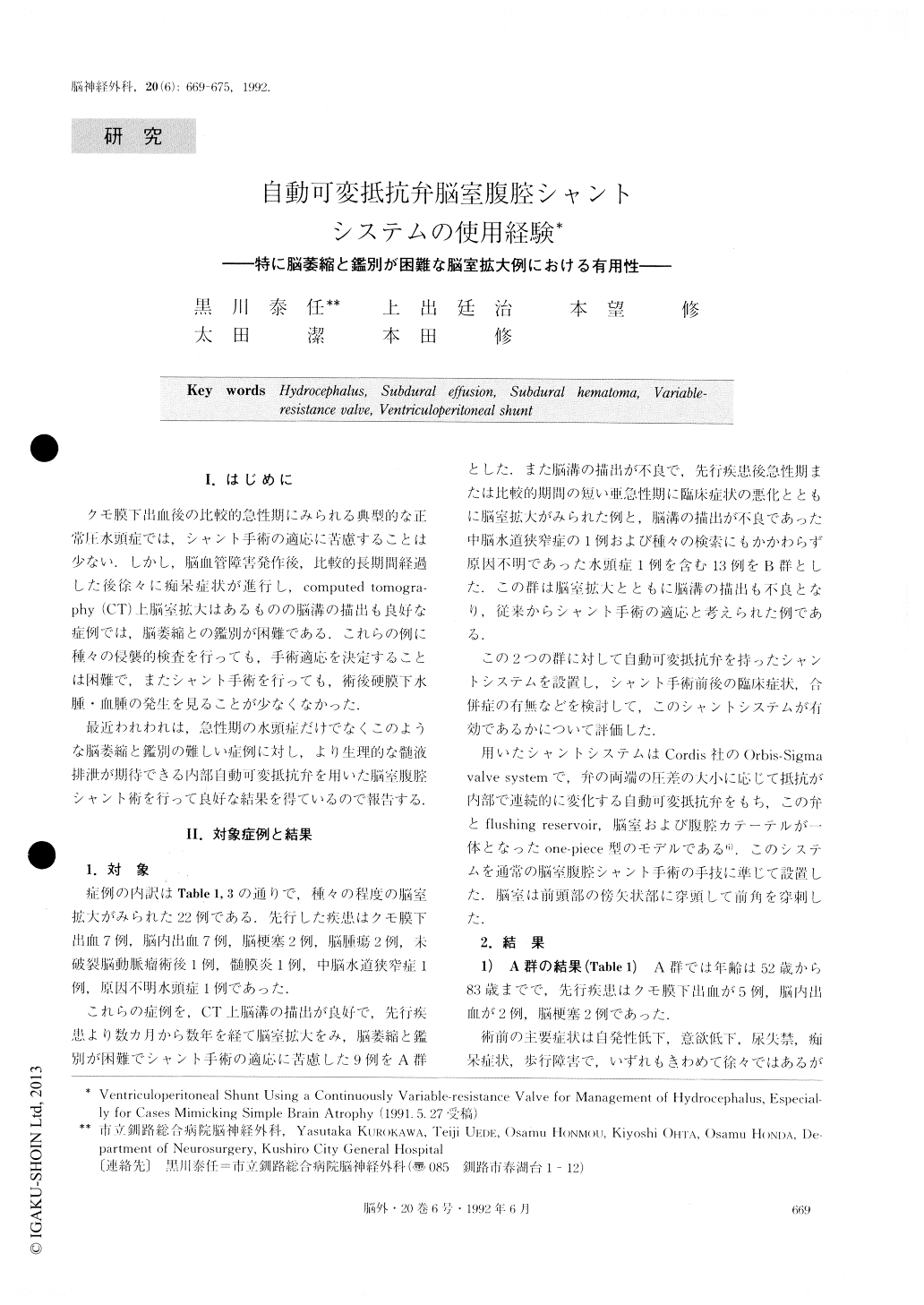Japanese
English
- 有料閲覧
- Abstract 文献概要
- 1ページ目 Look Inside
I.はじめに
クモ膜下出血後の比較的急性期にみられる典型的な正常圧水頭症では,シャント手術の適応に苦慮することは少ない,しかし,脳血管障害発作後,比較的長期間経過した後徐々に痴呆症状が進行し,computed tomogra—phy(CT)上脳室拡大はあるものの脳溝の描出も良好な症例では,脳萎縮との鑑別が困難である.これらの例に種々の侵襲的検査を行っても,手術適応を決定することは困難で,またシャント手術を行っても,術後硬膜下水腫・血腫の発生を見ることが少なくなかった.
最近われわれは,急性期の水頭症だけでなくこのような脳萎縮と鑑別の難しい症例に対し,より生理的な髄液排泄が期待できる内部自動可変抵抗弁を用いた脳室腹腔シャント術を行って良好な結果を得ているので報告する.
Twenty-two hydrocephalic patients with a ventricu-loperitoneal shunt using a continuously variable flow resistance valve (Orbis-Sigma valve system ; Cordis Corporation, USA) were reviewed to discuss usefulness of the shunt system. We divided the eases into two groups according to the demonstration of the cortical sulci in computed tomography (CT) as follows ; A : progressive hydrocephalic cases mimicking simple brain atrophy, B: acute or subacute hydrocephalic cases with evidence of increased intracranial pressure.
Patients in Group A had begun to present slowly progressive loss of activity, dementia and gait disturb-ance of various degrees after a long quiescent period following primary central nervous system injury. CT findings of these cases showed they were mimicking simple brain atrophy. Although the period of their de-terioration was very long, ranging from 1 month to nine years, clinical signs improved in all cases after the shunt. None showed complications.
creased intracranial pressure such as consciousness dis-turbance, nausea and vomiting. These cases showed poor demonstration of the cortical sulci in CT. Eleven out of thirteen cases showed satisfactory clinical im-provement, though the size of the ventricle showed a slight decrease following shunt procedure. Only one case showed unilateral subdural effusion. In conclusion, this shunt system is useful for the management of ventricular enlarged cases mimicking simple brain atrophy as well as acute hydrocephalic cases. Troublesome consequences such as subdural effusion and hemorrhage rarely occur even in cases with low cerebrospinal pressure.creased intracranial pressure such as consciousness dis-turbance, nausea and vomiting. These cases showed poor demonstration of the cortical sulci in CT. Eleven out of thirteen cases showed satisfactory clinical im-provement, though the size of the ventricle showed a slight decrease following shunt procedure. Only one case showed unilateral subdural effusion.
In conclusion, this shunt system is useful for the management of ventricular enlarged cases mimicking simple brain atrophy as well as acute hydrocephalic cases. Troublesome consequences such as subdural effusion and hemorrhage rarely occur even in cases with low cerebrospinal pressure.

Copyright © 1992, Igaku-Shoin Ltd. All rights reserved.


